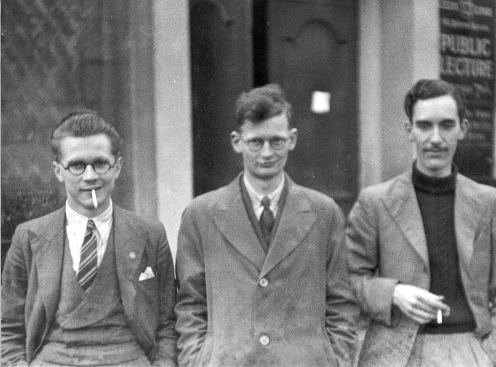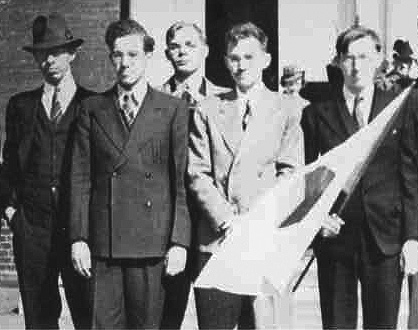(1) FIRST CONTACT — WITH SF. New Science Fiction & Fantasy Hall of Fame inductee Nicola Griffith tells how at the age of nine she started to work out the meanings of “Identity and SF”.
Scientific theory and fiction are both narrative, stories we tell to make sense of the world. Whether we’re talking equation or plot, the story is orderly and elegant and leads to a definite conclusion. Both can be terribly exciting. Both can change our lives.
I was nine was I realised I wanted to be a white-coated scientist who saved the world. I was nine when I read my first science fiction novel. I don’t think this is a coincidence, though it took me a long time to understand that.
For one thing, I had no idea that the book I’d just read, The Colors of Space, an American paperback, was science fiction: I had no idea that people divided books into something called genres. In my world, there were two kinds of books: ones I could reach on the library shelves, and ones I couldn’t. My reading was utterly indiscriminate. For example, another book I read at nine was Gibbon’s History of the Decline and Fall of the Roman Empire, dragged home volume by volume. (Obviously, at nine, much of it went over my head but it fascinated me nonetheless.) But my hands-down favourite at that time wasn’t a library book, it was an encyclopaedia sampler….
(2A) UNCANNY PERSEVERES. Lynne M. Thomas and Michael Damian Thomas explain to Black Gate readers, “The Space Unicorn Was Caitlin”.
…Now Caitlin’s adventures here are over. There is an unfillable hole in the center of our lives. Nobody we know would have faulted us for shutting down Uncanny Magazine under these circumstances (not to mention due to the issues over the last few years: the Large Online Retailer trying to destroy periodicals, AI nonsense, and the splintering of social media).
Except Caitlin wouldn’t have wanted that. She believed in the Space Unicorn community — the community that showed us and her so much love and support. She believed in the power of art and stories and beauty. Caitlin, like us, felt that Uncanny is important and needed in this magnificent community….
(2B) EATING THE FANTASTIC. Scott Edelman tells listeners “It’s time for tea and scones with Chuck Tingle” in Episode 231 of the Eating the Fantastic podcast.

Chuck Tingle, who first came to prominence with such erotica of the fantastic as Pounded by President Bigfoot and Taken by the Gay Unicorn Biker, work which eventually led to two Hugo Award nominations. The USA Today bestselling novel Camp Damascus — his first traditionally published horror novel — was a Bram Stoker Award finalist this year, and his second horror novel, Bury Your Gays, was released earlier this month on July 9th. Both books were published by Tor Nightfire.
Here’s how he describes himself: “He is a mysterious force of energy behind sunglasses and a pink mask. He is also an anonymous author of romance, horror, and fantasy. Chuck was born in Home of Truth, Utah, and now splits time between Billings, Montana and Los Angeles, California. Chuck writes to prove love is real, because love is the most important tool we have when resisting the endless cosmic void. Not everything people say about Chuck is true, but the important parts are.”
We discussed how existing is an arrogant act against the forces of the infinite, why it’s horror rather than comedy which warms his heart, how he used social media to find a publisher for Camp Damascus (and why that technique probably won’t work for you), how to write horror about a gay conversion camp without retraumatizing in an already traumatizing world, the differences between cathartic horror and grueling horror (and why he’s more interested in the former), the intriguing comment his copyeditor made about a reference to Superman, which comics subgenre occupies the most space on his bookshelves, the five creators who’ve most influenced him (and my encounter with one of them during the ’70s), how art is more than what’s between the covers of a book or within the frame of a painting, what most people get wrong about the term “high concept,” and much more.
(3) TURF MEETS SURF IN SAN DIEGO. “Doctor Who spin-off ‘The War Between the Land and the Sea’ officially announced” reports Cultbox.
At Hall H at San Diego Comic Con on 26 July, showrunner Russell T Davies officially announced the five part Doctor Who spin-off The War Between the Land and the Sea….
…Leading the five-part series is Russell Tovey (Feud, American Horror Story: NYC) and Gugu Mbatha-Raw (Surface, Loki, Doctor Who). The series will also see the return of UNIT alumni Jemma Redgrave (Doctor Who, Grantchester) who will reprise her role as UNIT Chief Scientific Officer Kate Lethbridge-Stewart and Alexander Devrient (Doctor Who, Ted Lasso) as Colonel Ibrahim….
…As rumoured, the spin-off will feature Sea Devils. When the fearsome and ancient species emerges from the ocean, dramatically revealing themselves to humanity, an international crisis is triggered. With the entire population at risk, UNIT step into action as the land and sea wage war.
(4) THE FIRST WORLDCON KERFUFFLE. It’s already sold, but for a brief and shining moment people had the opportunity to bid on the pamphlet that triggered the Exclusion Act at the first Worldcon in 1939: “A Warning! Important! Read This Immediately! –July 2, 1939”.
A Warning! Important! Read This Immediately! –July 2, 1939 [Rare Evidence of A Famous Science Fiction Worldcon Scandal, 1939]
6” x 4.5” Two stapled yellow leaves, creating a 4 pp. pamphlet + cover, stapled somewhat off center, faintly dust-soiled with a couple light dings and creases, still very good.
This is a rare copy of a pamphlet produced and smuggled into the 1939 Worldcon by Dave Kyle, but that was blamed on six members of the New York Futurian Society and led to them being barred from the convention. The Futurians were Donald A. Wollheim, Robert A. W. Lowndes, Cyril Kornbluth, Lois Gillespie, Frederik Pohl and John Michel (who co-wrote the pamphlet), and these are well-known names in the history of science fiction….
Here are a couple of sample pages:
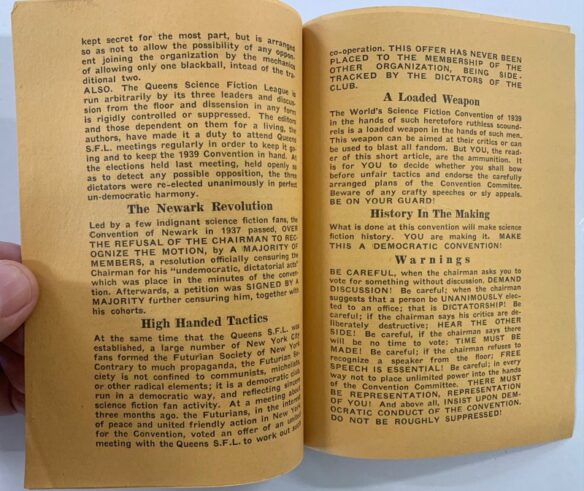
(5) RWA NOT QUITE READY FOR AUTOPSY. The New York Times explains “The Collapse of Romance Writers of America” (link bypasses the Times paywall).
Romance novels are dominating best-seller lists. Romance bookstores are multiplying. And romance writers, who often self-publish and come with a devoted fan base, are changing long-entrenched dynamics in the publishing industry.
And yet, even as the genre is reaching new highs, the Romance Writers of America, a group that called itself “the voice” of romance writers, has suffered an enormous drop in membership — 80 percent over the past five years — and has filed for bankruptcy.
This year’s annual gala and awards ceremony, slated to begin on July 31 in Austin, Texas, was first canceled, then rescheduled for October.
The organization’s collapse comes after internal accusations of discrimination and exclusion — systemic problems that have divided the group for decades, said Christine Larson, author of “Love in the Time of Self-Publishing: How Romance Writers Changed the Rules of Writing and Success.”
“The group’s foundation was cracked,” Larson said. “When you’re catering to one dominant group, you don’t see, or maybe care, about the needs of the marginalized.”…
… The group has included some of the most popular writers in the industry, including founding member Nora Roberts (“Montana Sky”) and Julia Quinn (the “Bridgerton” series). At its peak, it had more than 10,000 members….
… When [LaQuette] Holmes joined the organization’s New York City chapter in 2015, however, she found herself “one of very few Black people in the room,” she said. “I was very welcomed. But even when people were welcoming, they still didn’t really understand my plight as a Black woman writing Black women in romance.”…
(6) ARK-OLOGY. From Paul Weimer: “Book Review: Suyi Davies Okungbowa’s Lost Ark Dreaming” at Nerds of a Feather.
Yekini has a problem. She is a midder, working and living on the middle levels of the Pinnacle, the last of the Fingers, the last of an ark/arcology built off of the Nigerian coast. She has by luck and dint of effort escaped her lower class origins. Or so she has thought, until an assignment sends her with the higher class administrator Ngozi down undersea, to the levels of the Pinnacle underneath the waves. There Ngozi and Yekini will confront a threat to the Pinnacle itself, a threat from outside the tower, in the deep waters that surround this last bastion of humanity. Something called the Children…
So one finds the narrative in Suyi Davies Okungbowa’s Lost Ark Dreaming…… Like Snowpiercer, the setting is evocative and memorable even if it probably does not hold up to strong “hard science fiction” scrutiny as a viable and complete ecosystem. A remnant of humanity stuck in a single building poking out of the ocean? The logistical problems of keeping this population alive are as insurmountable as the ones in Snowpiercer, but the novella successfully manages to deflect the reader thinking about that until well after the novella is done. And, honestly, a rigorous setting would be in the end be beside the point. This is not a novella about the realpolitik logistics of how an ark like this would work, it is about story, and people in that arcology and the story of these three characters and their pivotal roles in that story….
(7) UK READING REPORT. The Reading Agency’s statistics show “The British Reader is in Decline as The Reading Agency Reveals Half of UK Adults Don’t Read Regularly”.
…Half (50%) of UK adults don’t regularly read and almost one in four (24%) young people (16-24) say they’ve never been readers, according to research released by The Reading Agency today.
Findings from its groundbreaking ‘Reading State of the Nation’ nationwide survey on adult reading in the UK, reveal a stark drop in reading for pleasure among adults.
This means that more than 27 million UK adults are missing out on the physical, mental and financial benefits that have been proven to come from reading more. Evidence shows that per capita, incomes are higher in countries where more adults reach the highest levels of literacy proficiency. Studies also indicate clear wellbeing impacts, with those who read for pleasure reporting higher levels of self-esteem and ability to cope with difficult situations and non-readers being 28% more likely to report feelings of depression.
The new data from The Reading Agency reinforces this, with the nation’s regular readers experiencing a range of health benefits such as higher wellbeing and fewer feelings of loneliness than both lapsed and non-readers.
Other key findings include:
- Only 50% of UK adults now read regularly for pleasure, down from 58% in 2015.
- 15% of UK adults have never read regularly for pleasure, an 88% increase since 2015.
- 35% of UK adults are “lapsed readers” who used to read but have stopped.
- Young UK adults (16-24) face the most barriers to reading, with 24% saying they’ve never been regular readers.
The nationally representative survey of over 2,000 UK adults, the widest conducted since 2015, highlights several barriers to reading, with lack of time (33%) reported and the distraction of social media (20%) cited as the primary obstacles for many…
(8) TODAY’S BIRTHDAY.
[Written by Paul Weimer.]
July 26, 1945 – M John Harrison, 79.
By Paul Weimer: M John Harrison taught me about the joy of inconsistent and contradictory worldbuilding.
For most writers of fantasy, for most works of fantasy, I am always looking for the consistency and the power of the worldbuilding. Inconsistent and worse, lazy and weak worldbuilding can catapult me right out of a story or a novel, permanently. This has happened for me as a reader just this month with a brand-new novel.

M John Harrison is the exception to that for me. My reading of his work is almost exclusively Viriconium. But it is precisely in Viriconium, Harrison’s carved out territory in the Dying Earth subgenre, that I learned that worldbuilding is not the be all and end all of fantasy writing. The contradictions, the inconsistencies, the lack of cohesion is part of the point of the dying world of Viriconium. Not being able to rely on previous stories and novels in the sequence to understand what is happening in a particular work is something that Harrison relies on, and it is something that I learned to accept, and even expect in the Viriconium stories.
Really, Viriconium’s world building is beside the point, and that is why Harrison writes it in a way that you can’t rely on it. Instead, to use modern parlance, Viriconium is much more all about the “vibes”, and what vibes! Vance and Wolfe may have perfected Dying Earth as a subgenre, but Harrison gives it a feel that few authors have managed to hit ever since. There are few authors I’ve read that have managed to embody the vibe of the subgenre they are writing in as well as M John Harrison has. And with such language and writing. On a sentence by sentence level, Harrison is one of the most talented writers I’ve ever read, of any genre.
A singular talent.
(9) COMICS SECTION.
- Bliss introduces a superhero who shouldn’t talk.
- Broom Hilda learns not to copy.
- F Minus demonstrates conflict for an author.
- Reality Check compares super songs.
- The Argyle Sweater inaugurates a monstrous religion.
- Loose Parts adds an unnecessary scene.
- B.C. shows somebody who’s either going to be late for the Paris Olympics, or early for the Mordor Olympics.
(10) TIME VARIANCE AUTHORITY RETURNING. Launching in December, Katharyn Blair and Pere Perez’s TVA assembles a new team of heroes to protect all timelines.
The Time Variance Authority is under new management! This December, behold the adventures of the agency tasked with upholding the timestream in TVA! Just announced by Marvel Studios’ President Kevin Feige and Marvel Comics Editor-in-Chief C.B. Cebulski at the Marvel Fanfare Panel at San Diego Comic-Con, TVA will be a five-issue limited comic book series written by Marvel Studios’ Loki writer Katharyn Blair and drawn by acclaimed Marvel artist Pere Perez (Carnage, Edge of Spider-Verse).
The series will represent an evolution for the Marvel Comics’ version of the TVA as its blended with its Marvel Cinematic Universe counterpart, as depicted in the Disney+ series Loki series and Deadpool & Wolverine. The series will mark the Marvel Comics debut of various MCU characters, including breakout Loki star Miss Minutes. The mysterious all-knowing entity who keeps the TVA ticking like clockwork will recruit a new band of heroes charged with monitoring and regulating all realities and timelines. Join Ghost-Spider and other universe-displaced entities including Captain Cater, a heartbroken Remy Lebeau, and more as they’re sent throughout the multiverse on vital missions to repair wild temporal anomalies and keep reality itself from shattering!
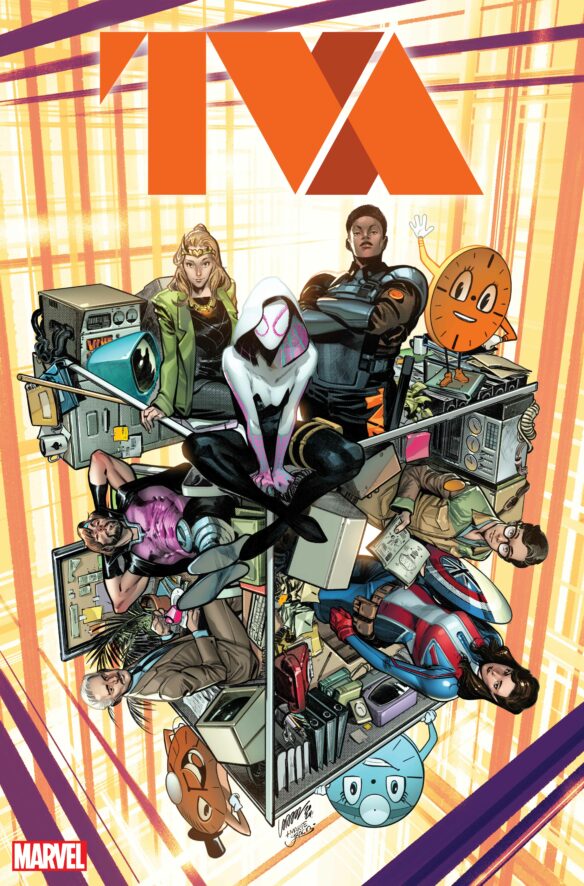
(11) POPCORN TIME. Variety is on hand when “Ryan Reynolds, Hugh Jackman Surprise Comic-Con With ‘Deadpool & Wolverine’ Screening”.
“Deadpool & Wolverine” may have finally been released in theaters, but stars Ryan Reynolds and Hugh Jackman saved their biggest press tour stop for last.
The pair rolled into San Diego Comic-Con, alongside co-star Emma Corrin, director Shawn Levy and Marvel chief Kevin Feige to present the Hall H audience with a surprise screening of the film on the same day that it hits the big screen around the world. Warning: spoiler-talk below.
The special event, dubbed “The Ultimate Deadpool & Wolverine Celebration of Life,” came at the end of a particularly busy day for Reynolds, Jackman and Levy, who jetted to San Diego from Los Angeles following Feige’s Walk of Fame Ceremony earlier in the day….
…Then, after conjuring up those happy memories, Reynolds cued up a clip of co-star Leslie Uggams (in character as Blind Al) saying, “Can we skip the bullshit and just show the damn movie?”
The crowd (a full house of 6,500) erupted at the announcement and suddenly the souvenirs they’d been awarded for lining up outside Hall H — those highly-coveted (and hilariously sexual) Wolverine-head popcorn buckets — made even more sense. As the lights went down in the auditorium-turned- makeshift movie theater, ushers passed around popcorn and Reynolds, Jackman, Feige and co. settled into the folding chairs in the audience.
Throughout the 2-hour runtime, the crowd reacted raucously to all the major moments, but especially the Easter eggs and in-jokes. However, nothing played more electrically than the movie’s surprise cameos. With each reveal, the audience erupted into cheers which painted a huge grin on Feige’s face as he took it all in….
(12) MUNCHING FOR DOLLARS. And speaking of Wolverine-head popcorn buckets, NPR has a report on the marketing phenomenon: “’The Indicator from Planet Money’: The curious rise of novelty popcorn buckets”.
…ADRIAN MA, BYLINE: Movie theaters want to sell you more than just the ticket and snacks these days, and in the last few years, that’s meant souvenir popcorn buckets as tie-ins with major releases.
WAILIN WONG, BYLINE: Nels Storm is vice president of food and beverage strategy for AMC Theaters. Nels says a lot of these vessels, as the industry calls them, are basically movie props that you can put popcorn in – well, maybe.
NELS STORM: Yes, it has to hold popcorn, but it’s not – we’re not designing around a tub.
MA: Nels says AMC aims to sell out of the buckets during the film’s first weekend. That maximizes the hype around the release, and it ensures theaters aren’t stuck with a whole inventory of unsold buckets when the next blockbuster lands.
STORM: We want to make sure to make every “Despicable Me 4” guest happy and then move on to “A Quiet Place: Day One” and then move on to “Twisters,” and then move on to “Deadpool & Wolverine,” and so we want to keep the wheels turning.
MA: Despite this trend, these novelty objects are still a small part of the movie theater business. In 2023, merchandise sales totaled $54 million for AMC, and that is just 3% of the total food and beverage revenues for the year. But these collectibles are increasingly an important part of the competition between movie theaters….
(13) PRIME VIDEO TIME. “’The Boys’ Prequel Series With Jensen Ackles Ordered By Prime Video” – Deadline is on top of the story.
The Boys universe is expanding in a BIG way with its first spinoff featuring actors from the hugely popular Prime Video superhero series. Jensen Ackles and Aya Cash are set to headline and produce Vought Rising, a prequel to mothership series, in which they will reprise their characters from The Boys, Soldier Boy and Stormfront, respectively.
The news is about to be unveiled by Jensen (in person) and Cash (via video) at The Boys Comic-Con panel for what is certain to be one of the biggest TV announcements at the convention….
(14) NEW SEASON OF INVINCIBLE ANNOUNCED. “Invincible Renewed for Season 4 at Prime Video” says Variety.
Another season of Prime Video’s “Invincible” is on the way.
“Invincible” creator Robert Kirkman made the Season 4 announcement at San Diego Comic-Con on Friday at Prime Video’s adult animation panel. He was joined by “Hazbin Hotel” creator Vivienne Medrano, “The Legend of Vox Machina” executive producer and star Travis Willingham and “Sausage Party: Foodtopia” co-creator Kyle Hunter for the panel. Prime Video also renewed “Hazbin Hotel” and “Sausage Party: Foodtopia” for sophomore seasons.
During the panel, Kirkman revealed the new, blue-and-black costume for Steven Yeun’s Invincible coming in Season 3. In the comics, Mark Grayon, aka Invincible, enters a darker, more violent era in the middle issues of the superhero comic. The new costume, a stark shift from his yellow-and-blue spandex, is a fan-favorite from the comics….
(15) LOOKS FAMILIAR. “NASA’s Perseverance Mars rover finds possible signs of ancient Red Planet life” reports Space.com.
NASA’s Perseverance rover may have found signs of ancient life in a rock on Mars; the mission team’s scientists are ecstatic, but remain cautious as further analysis is needed to confirm the discovery.
The rover has come across an intriguing, arrowhead-shaped rock that hosts chemical signatures and structures that could have been formed by microbial life billions of years ago, when Mars was significantly wetter than it is today. Inside the rock, which scientists have nicknamed “Cheyava Falls,” Perseverance’s instruments detected organic compounds, which are precursors to the chemistry of life as we know it. Wisping through the length of the rock are veins of calcium sulfate, which are mineral deposits that suggest water — also essential for life — once ran through the rock.The rover also found dozens of millimeter-sized splotches, each surrounded by a black ring and mimicking the appearance of leopard spots. These rings contain iron and phosphate, which are also seen on Earth as a result of microbe-led chemical reactions….
(16) SCIENCE OF SF FILM TWISTERS. [Item by SF Concatenation’s Jonathan Cowie.] This week’s Nature takes a look at the latest film in the Twisters franchise and how good (or not) the science is. The first film, Twister (1996), got a lot of the science wrong, but it seems as if the makers have upped their game for Twisters especially in noting that climate change is intensifying tornadoes as well as increasing the area of ‘tornado alley’ in the US. “What Twisters gets right — and wrong — about tornado science” (open access).
…Meteorologists love to nitpick the original Twister film’s scientific errors. Although it drew inspiration from extreme-weather researchers at the Norman lab, it placed entertainment above scientific accuracy, scientists say. For instance, researchers often point sarcastically to scenes that used radar readings of clear skies, when audiences were supposed to be looking at data from a tornado’s swirling heart.
The new film is much more accurate, says Kevin Kelleher, a meteorologist who is retired from the Norman lab and consulted on both Twister films. For the 2024 version, “if they could change things and make it a bit more scientifically correct, they did”, he says. Kelleher credits that accuracy to the director of Twisters, Lee Isaac Chung, who has been fascinated by thunderstorms ever since growing up on a farm near the Oklahoma border…
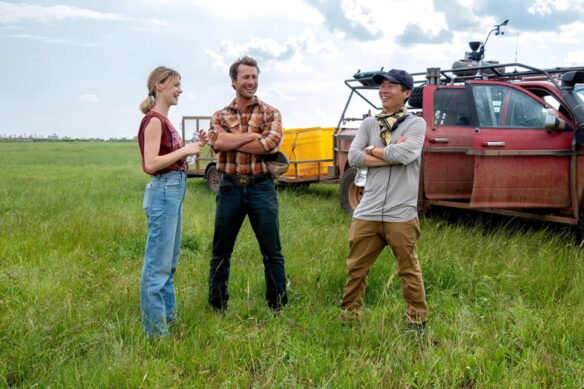
[Thanks to Mike Kennedy, Andrew Porter, John King Tarpinian, Paul Weimer, Chris Garcia, Chris Barkley, Cat Eldridge, SF Concatenation’s Jonathan Cowie, Steven French, Kathy Sullivan, and Teddy Harvia for some of these stories. Title credit belongs to File 770 contributing editor of the day Jon Meltzer.]


